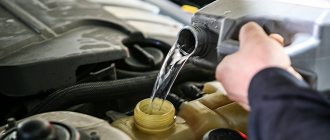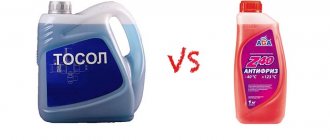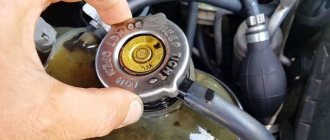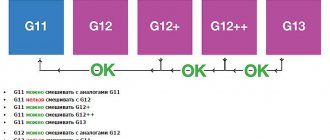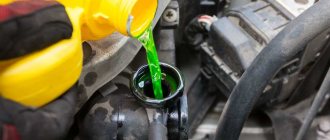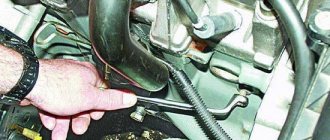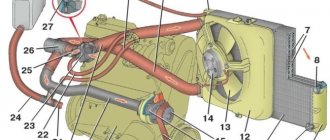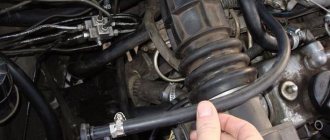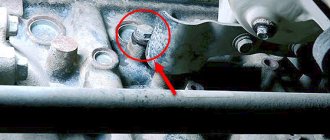Servicing a modern car is a rather complex task that includes many nuances. One of them is maintaining an optimal level of antifreeze. The efficiency of engine cooling will depend on this operation. Novice motorists often do not pay enough attention to this aspect. As a result, breakdowns may occur on the road, and the resource of the power unit is “burned out” unreasonably quickly. To prevent this from happening, you should figure out how often you need to add antifreeze to your car. But first, a little theory.
Why should you add coolant?
Antifreeze is the common name for special engine coolants. During operation, they circulate through a special circuit, which allows the generated heat to be removed. The heated antifreeze is transferred to the radiator, where it is rapidly cooled. If there is not enough process fluid or its quality is lost, then the temperature of the power unit will rapidly exceed the limit level. An overheated engine wears out quickly and may stall or even seize.
How to add refrigerant
Sometimes adding coolant is enough. In this case, it is extremely important to use the refrigerant of the same composition, preferably from the same manufacturer. This is best done on a cold or slightly cooled engine. It is necessary to open the system covers, and then fill the radiator almost to capacity. If the coolant level has been too low and air pockets have formed in the system, you may need to run the engine for a few minutes with the caps open to relieve excess pressure.
In the summer heat, distilled water can be added to antifreeze. It is not recommended to mix plain water, antifreeze or antifreeze with each other. If this cannot be avoided, the system will need to be flushed and new coolant added soon.
Why antifreeze
It would seem, why use special fluids if water can also cool the engine? In fact, buying antifreeze is a necessity. Water evaporates quickly and can freeze, and it also activates corrosion processes and forms scale deposits. Automotive coolant is made from ethylene glycol and water. The resulting solution of dihydric alcohol does not freeze even at low temperatures and practically does not boil away when heated strongly. In addition, antifreeze contains a complex composition of corrosion inhibitors that slow down and stop oxidation processes.
You may be interested in: How often to change antifreeze when you need to replace the coolant
Choosing antifreeze for gravy
To determine which coolant needs to be filled, refer to the manual or reference literature provided by the car manufacturer. Typically, the manufacturer gives the user the right to choose, allowing the use of one of several options for technical fluids. It is recommended to add only the antifreeze that is already in the system.
It is allowed to mix funds of only one class. It is not the color of the liquid that will help you identify your classmates, since there is no single approach to ranking, but a special marking on the label.
Almost every country has its own standards for the quality of petroleum products. Manufacturers, in order to make things easier for car enthusiasts, adopted a unified classification, which was once developed by Volkswagen AG.
Coolant classes:
- G11 – possible marking Traditional or Convertional coolants, IAT (Inorganic Acid Technology). But there are packages without such signs at all;
- G12 - Carboxylate coolants or OAT (Organic Acid Technology);
- G13.
G11 is produced using traditional (silicate) technology. The composition includes various combinations of inorganic substances (amines, nitrates, silicates, phosphates, borates, nitrites).
In 2008, class G12 (G12+, G12++) appeared - these are carboxylate antifreezes made using silicate technology. Carboxylic acids are added to them as additives. G12+ is also labeled as Hybrid coolants or HOAT (Hybrid Organic Acid Technology).
G13, which entered the market in 2012, is made on the basis of propylene glycol, which is harmless and environmentally friendly. Technologically, this class is equivalent to G12++ and differs only in its environmental friendliness. G12+, G12++ and G13 are also labeled as Lobrid or SOAT coolants.
Most manufacturers adhere to this scheme for dividing coolant by color:
- G11 can be blue, green or blue-green;
- all G12 are red in any variations (from orange to purple);
- G13 is most often purple or pink, but other options are possible.
Compound
The answer to the question of how to add antifreeze contains several points. In order for coolant to be added correctly, you need to take into account the characteristics of your car. If you decide that it is time to update the amount of refrigerant in the cooling system, you need to pay special attention to the composition. All antifreezes are divided into categories or classes:
G11.
These are traditional liquids based on ethylene glycol, water and silicate additives. They have a completely inorganic composition, so they can only be mixed with each other. For these antifreezes, manufacturers usually choose colors such as blue, green and sometimes yellow.
G12.
These are coolants that are called organic or carboxylate. Their base is also ethylene glycol, but compositions with carboxylic acid are used as additives. Such substances can be combined with the same or with antifreezes, the labeling of which contains advantages. Most often, such liquids are painted in warm colors: red, purple, pink and orange.
G12 (with pluses).
These are hybrid compositions that contain both silicate additives and organic additives based on carboxylic acid. They are suitable for mixing with other liquids from this category or with refrigerants of the G12 category. By color you can most often find bright yellow, lilac, purple and scarlet antifreezes of this class.
G13.
These substances are known as lobrids because they are significantly different from other refrigerants. The composition of coolant belonging to this category is based on propylene glycol. Therefore, such compositions can only be mixed with each other. They are painted in lilac, pink and purple colors, but sometimes you can also find yellow G13 class antifreeze.
MULTIFREEZE.
This liquid is a unique product that can be mixed with representatives of any class. Its composition is compatible with both traditional inorganic and carboxylate antifreezes. Multifreeze is also suitable for adding to hybrid and lobride liquids.
Is it possible to add incompatible compounds to the cooling system? No, this will damage the car. If you do not know what kind of antifreeze was poured into the car at the factory, it is better to drain the remaining amount. This must be done so that the new product does not enter into an unpredictable chemical reaction with it.
How does engine performance depend on antifreeze?
So, we know that without proper operation of the ODS, the engine can overheat, and in addition, if the cooling is poor, corrosion processes can occur. It is recommended to replace antifreeze or antifreeze every 40 thousand kilometers, but according to experts, such replacement must be done annually
High-quality antifreeze allows you to avoid corrosive processes, it is softer in structure and has many additives; its characteristics differ markedly from cheap liquids in a number of indicators.
There is a lot of information about antifreeze or antifreeze and how they work in the engine system too. However, not many people understand how to properly top up or fill them, but the condition of the engine and, in general, the entire operation of your car depends on this.
Frequency
How often do you add antifreeze and is it necessary to do so? It is impossible to give a definite answer to this question. It all depends on the following variable factors:
- type of coolant;
- refrigerant composition;
- additive compositions;
- car brand;
- features of vehicle operation.
it is important! Today, the market offers coolants made on the basis of silicate and carbosilicate. Original silicate antifreeze from a good manufacturer retains its quality for 3 years or 150 thousand km. Carbosilicate liquids can last up to 5 years or 250 thousand km. When deciding to add antifreeze to your car, you must first read the recommendations of the car manufacturer.
Features of the brand.
Some manufacturers, such as Volkswagen, Mazda and GM, claim that adding coolant is not required at all. Throughout its entire service life, the car will run on factory antifreeze. But in reality, it all depends on the operating conditions of the car and its mileage. Therefore, we recommend checking the antifreeze level at least every 5 years.
What you need to know to fill antifreeze correctly
Let's start with the fact that it is impossible to mix coolants with different properties, since such a mixture can result in an insoluble precipitate. This will cause the radiator passages and other sensitive parts of the system to become coked over time. To avoid such situations, you only need to fill the car with antifreeze approved for use by the manufacturer of the particular car, and add a similar composition that complements the existing liquid.
The behavior of the cooling composition when water is added to it is an open question. To a certain extent, a diluted mixture can show excellent qualities, provided that distilled water is used. Regular tap water will not work here.
It is worth recalling that the color of the coolant does not depend on its composition. For example, blue and red refrigerant may be absolutely compatible, while two different green liquids will ultimately have different bases and additive compositions.
Many car owners make the mistake of not knowing where to pour antifreeze. And out of ignorance, they always use the radiator socket for this. This hole is indeed present in this device, but only in its collapsible models. Liquid should not be poured or topped up directly into a radiator system with a solid body. Antifreeze enters the radiator and other components of the cooling system through the expansion tank.
If the old fluid is completely replaced with a new one or its brand is changed, the existing refrigerant is drained from the collapsible radiator through an individual hole. The remaining liquid flows out through an additional plug, sometimes covered with a protective panel on the bottom.
A universal instruction will not always help here, since some car models are equipped with non-standard cooling systems with individual drain and fill circuits. This significantly differs the products of English automakers. The standard procedure for filling coolant is simple and consists of several steps that can be performed independently without the help of specialists.
Step-by-step instruction
If you are going to add antifreeze for the first time, you probably have questions:
- to what level should it be added;
- where to fill the fluid, into the tank or radiator.
We have prepared step-by-step instructions with which you can independently add refrigerant to your car when it is cold:
1 step.
First you need to install the car correctly. For convenience, it is better to place it on a slope so that the hood is higher than the trunk. This will allow air pockets, if they have formed, to escape from the cooling system pipes. If you need to add just a little liquid, you can leave the machine in a horizontal position.
Step 2.
Carefully open the expansion tank cap. In case there is high pressure in the system, cover it with a rag. For added protection, wear gloves to prevent injury to your hands.
Step 3.
Smoothly and slowly pour antifreeze into the hole. This should be done in a thin stream and gradually. Its level should reach approximately 2/3 of the expansion tank.
Step 4
Start the engine and keep it running for about 5 minutes. This will allow the coolant to distribute throughout the system. If after this the amount of refrigerant in the tank has decreased, you can add a little more.
Step 5
Close the lid, wipe it, the neck and surfaces that have been splashed with antifreeze.
Checking the tightness of the plug and tank
Stirring and constant movement can cause corrosion of the valve due to constant contact with the liquid. To avoid leaks, it is necessary to regularly check its condition. In addition to topping up, the plug should only be checked after the engine has completely cooled down. The valve is inspected and screwed back on. If it does not turn properly, it should be replaced.
You can check the tightness of the container using the holder. This is usually done at gas stations, but if you wish, you can arrange such a check yourself. The tank is carefully removed from the car. It has three holes. Two of them have shock absorption, and the rest are powered by air from a tire inflation pump. The test plug must be screwed in tightly. If, when creating high pressure inside the tank, the valve allows air to pass through, it must be urgently replaced.
If the valve maintains a pressure of 1.3 to 2 atmospheres, it also does not work. The optimal indicator of a good condition of the plug is when, at a pressure of 1.4 atmospheres or more, it opens and releases excess pressure.
After turning off the pump, it is necessary to maintain pressure in the tank - this ensures that the tank is in good condition and ready for further use.
How does operation affect
Abnormal engine operating conditions are a powerful factor in reducing the quality of the coolant. They may require topping up or completely replacing antifreeze. Typical negative factors include the following situations:
- prolonged operation of an overloaded vehicle;
- driving with low refrigerant levels;
- emergency topping up of unsuitable antifreeze;
- water entering the cooling system.
Consequently, the operating conditions of the vehicle also greatly influence how often antifreeze needs to be added.
How to pour antifreeze into the cooling system: opinions of car owners
- Concentrate and period “It is best and most profitable to purchase pure concentrate, not counterfeit and without temperature restrictions (for example, from VAG).
Drain off excess distillate based on the volume of your car's cooling system. Pour in the concentrated composition, checking the density of the liquid and adjusting it if necessary. It is important not to lower the temperature below -50 degrees, otherwise this will affect heat transfer, and it will be harder for the engine to work in the summer. The optimal temperature range is from -40 to -50 degrees. Alternatively, pour the finished composition at -50 degrees. The remaining water in the system will bring the temperature to the optimal value. But it all depends on the specific engine - will it be possible to drain a large volume from it?” - Face higher and forward
“Raise the front of your car as high as possible. Thanks to this, the air will leave the system very quickly. Next, fill the expansion tank with antifreeze to the level between the marks, then completely fill the thermostat through its neck and start the engine. The liquid will gradually drain away, so add it as you go. To make the air come out even faster, you can squeeze the upper pipe with your hands.” - Don’t rush, everything will be done in time
“Many people ask how much antifreeze should be poured. So, pour the “coolant” up to the mark and at the same time squeeze the pipes, then close the lid. Start the engine and warm it up until the radiator fan starts running. Next, increase the speed to 3000 and hold it for a minute. Turn off the engine and wait until it cools down completely. Then start the car again and, with the engine running, add antifreeze to the mark.” - Without topping up, change everything
“I think, instead of constantly topping up, it’s better to completely drain the liquid and pour fresh antifreeze into a clean, washed system. Never choose by the color of the liquid! Focus on the classes of antifreeze available on the market: G11 (there are blue and green) and G12 (in my opinion, only red). True, there are also red G11 fluids from Castrol. There are other nuances when choosing antifreeze. For example, it is impossible to use a more modern G12 instead of a previously filled G11, since the system is most likely not designed for the aggressive new composition.”
Typical mistakes when adding coolant
It is necessary to replenish the refrigerant level in the system not only on time, but also correctly. In their manuals, car manufacturers describe in detail all the details of the procedure. There are always recommendations on the packaging of any antifreeze. But to many motorists the process itself seems simple, so no one delves into the technical documentation. So that you can avoid common mistakes, we have prepared a rating of them.
1. Constant rush
Automotive and coolant manufacturers emphasize in bold letters, warnings, and exclamation marks the strict need to add antifreeze to a “cold” system. At a minimum, the car should stand with the engine turned off for at least 10 minutes. What are the consequences of a violation? First of all, it is dangerous.
it is important! When adding cold liquid to hot liquid, a characteristic bubbling begins. As a result, the hasty motorist gets burns on his hands and greasy stains in the engine compartment. But there is also a technical aspect. The heated liquid occupies the maximum volume, so you will only need to add a little. As it cools, the antifreeze level will drop, but you won’t notice it.
2. Adding water
The chemical composition of automotive coolant is calculated based on the standard water content - approximately 5%. At this concentration, all anti-corrosion, anti-foam and other performance properties of the product are preserved. If you simply add water, then it is no longer possible to guarantee any properties of the entire liquid. Such actions often lead to freezing, which ultimately damages the line and radiator. Adding water is allowed only in emergency situations, when you need to raise the coolant level, but there is nowhere to get a suitable composition. Immediately after an abnormal dilution of antifreeze, you need to go to a service station to flush the system and fill it with good refrigerant.
3. Sudden movements
This error is also related to security issues. It lies in the fact that some motorists sharply unscrew the filler cap. If the machine has recently been operated, such actions may result in the release of a large volume of hot steam. To protect yourself from burns, you need to act carefully and slowly.
4. The details were mixed up
Some motorists, especially those who have never encountered the problem of adding antifreeze, want to add it directly to the radiator. This can only be done with some car models; for others it is better to use an expansion tank. If the radiator design of your car is collapsible, you can add coolant there. But this will make it more difficult to determine its level in the system and prevent the occurrence of air locks.
5. More is not better
There is no need to confuse antifreeze and engine oil. If the latter needs to be filled to the limit, then it is better to stop the coolant level in the middle of the expansion tank. If there is an excess of liquid, its thermal expansion will lead to increased pressure in the system. At best, this will result in a cracked tank, but you may also encounter ruptures in the system.
6. Matching by color
Adding antifreeze according to rules like “red to red” or “blue to blue” is a gross mistake. In fact, no one regulates the color schemes of manufacturers. The choice of coolant should be based on its chemical composition.
Flushing the system
The need to flush the car's cooling system may arise in the following cases:
- The antifreeze used has become very black and/or thickened. In this case, it must be replaced completely, despite its specified service life. This fact can be caused by two main reasons - either you forgot to change the fluid according to the regulations, or you bought a fake.
- If it is necessary to add more than 30% of antifreeze to the existing volume. In this case, the existing “coolant” must be drained and the system flushed using distilled or ordinary water. You can also use other, more effective means for this.
How to flush the engine cooling system
There are at least 4 ways to flush the engine cooling system. One of them is to rinse the outer part with ordinary water, but it is better to rinse the inside with a solution of citric acid or a special product.
Results
Adding coolant is a simple procedure, and even an inexperienced car owner can handle it. The main thing is to follow safety precautions (perform the procedure with a cold engine and cooling system), and also choose the right antifreeze that you plan to add. Try to ensure that no air pockets form during the topping process. While operating the car, regularly monitor the coolant level, and if necessary, do not forget to add it or change it completely.
What should you do when pouring?
1) Find the necessary information about exactly what antifreeze is needed;
2) Buy exactly “Liquid ready to fill”, avoid concentrate, it cannot be added to the expansion tank;
3) Add only antifreeze of the same class;
4) Stop thinking about “Antifreeze”, these are liquids with different chemical compositions;
5) Allow the engine to cool;
5) Cover the “barrel” lid with a rag and open;
6) Top up if the level is missing up to 20% of the liquid from the entire volume of the barrel;
A little theory
Antifreeze is a coolant that constantly circulates in a closed circuit. The cooling circuit includes numerous channels in the engine and the radiator, where the antifreeze is directly cooled. As the car is used, the performance characteristics of such a coolant deteriorate; as a result, not only dense calcium deposits and sediment appear, but also metal elements begin to rust. Therefore, it will be necessary not only to regularly add coolant, but also to replace antifreeze.
If a car owner neglects such coolant maintenance, this ultimately leads to overheating of the engine, which can lead to critical engine failure. Whereas all such problems could be avoided by promptly replacing the antifreeze and constantly monitoring the coolant level in the expansion tank. Remember that if the coolant begins to quickly leave the system and you constantly need to add antifreeze, this may indicate serious problems with the engine. In such a case, comprehensive repairs and diagnostics of the car are necessary.
Which antifreeze to choose for your car
Choosing the right antifreeze is not an easy task; there is quite a large supply of them on the modern market. To make the right choice, you will need to initially decide what type of product will be used, antifreeze or antifreeze.
Most car enthusiasts prefer antifreeze as a higher quality and modern product.
Antifreezes have special characteristics:
- have a beneficial effect on the operation of the vehicle’s propulsion system
- extend its life
- allow you to operate the car in extreme conditions
- increase engine performance
- maintain performance characteristics over a wide temperature range
Antifreeze is supplied to the retail chain in the form of:
- ready-to-use solution
- concentrate, which will need to be dissolved in distilled water.
The performance characteristics of both liquids will be the same, but the concentrate is more convenient to store, because its volume is much smaller.
Watch a video about different types of antifreeze and their features:
